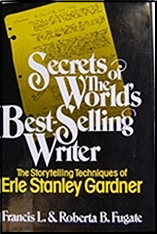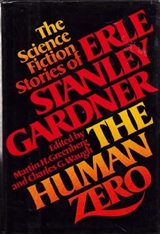Sun 25 Oct 2020
Two Archived ERLE STANLEY GARDNER Reviews.
Posted by Steve under Pulp Fiction , Reference works / Biographies , Reviews[10] Comments
FRANCIS L. & ROBERTA FUGATE – Secrets of the World’s Best-Selling Writer. Morrow, hardcover, 1980.
ERLE STANLEY GARDNER – The Human Zero: The Science Fiction Stories of Erle Stanley Gardner, edited by Martin H. Greenberg and Charles G. Waugh. Morrow, hardcover, 1981.
Erle Stanley Gardner often proudly referred to himself as a fiction factory. The total sales of all the books he ever wrote, in all languages and in all editions, is currently estimated at well over 300 million copies. His isolated ranch near Temecula, California, grew to include twenty-two buildings, designed to house himself, his secretarial staff, and his voluminous, all-inclusive archives.

All of his earliest writing was done for the “woodpulp” magazines, those ephemeral pieces of popular culture disdained at the time by librarians and the literary establishment alike. The covers were lurid and garish; the contents were written to match. If you were to find an attic filled with them today, you would have a small fortune on your hands.
By 1933, Erle Stanley Gardner was a household word. Series characters such as Lester Leith, Speed Dash, Ed Jenkins, Senor Lobo, Sidney Zoom, and scores of others were the lifeblood of a list of pulp magazines a page long. In that year alone, Gardner had a total of seventy short stories, novelettes, and articles see print.
It was also the year that Perry Mason came along. Morrow published The Case of the Velvet Claws in March of that year, and The Case of the Sulky Girl followed in quick order. In 1934 Gardner’s production of short pieces fell off a bit, to something just under forty or so, but to compensate there were three more Mason novels.
Perry Mason immediately captured the nation’s attention. Originally conceived as a hard-boiled attorney named Ed Stark, straight from the pages of Black Mask magazine, which also gave Dashiell Hammett and Raymond Chandler good running starts on their careers, Mason went on to be the star performer in a total of eighty-five novels.
They were formula stuff, but Gardner. knew exactly what his readers wanted. Each of the cases culminated in a courtroom scene, with a trial and the future of Mason s client hanging in the balance. Gardner’s own background as a practicing attorney helped provide for some of the trickiest shenanigans ever devised, most of it well beyond the reach, one imagines, of even such superstars of the profession as F. Lee Bailey and Louis Nizer, to name two.
There were also comic strips, a radio show, and, of course, the long-running Raymond Burr television vehicle, and all had Gardner as the guiding hand.
Details of Gardner at work – since he was paid by the word for his work for the pulps, he had a gadget on his typewriter that counted off another tally every time he hit the space bar; of his struggle to change his style sufficiently to get the first book published; of his characters (the real reason Della Street never married Perry Mason, for example); and his philosophy of writing (begin with a mystery and tell a story that people want to read) – are all to be found in the Fugate book, published late last year.

It is based primarily on Gardner’s papers, transferred en masse to the University of Texas upon his death in 1970. In this wealth of material lies a fabulous practical how-to-do-it manual for prospective writers. Gardner’s style was functional, to say the most. In his mysteries he emphasized plot above all, which places him slightly out of step in today’s world, but as of 1979 it is reported that he was still averaging 2,400 sales a day, every day of the year.
That Gardner also wrote science fiction will probably come as a surprise to many, but in The Human Zero, Gardner’s entire output of fantastic stories is reprinted, all of it from Argosy magazine between 1928 and 1932.
As science fiction, from today’s perspective, the science in these tales is shaky and the fiction is worse. These seven stories are filled with mad scientists, strange inventions, catastrophic calamities, and bizarre theories of evolution. But in those days between the World Wars, this was the nature of the field, and what Gardner wrote was no worse than any of the rest of it.
Still, science fiction was obviously not his forte, and he was probably glad to leave it. Perry Mason was his ticket to success, not imaginary flights to Venus in backyard anti-gravity machines.
In essence, what Greenberg and Waugh give us here in the first of a series planned to resurrect much of Gardner’s work from the “woodpulp” pile, are the skeletons of Gardner’s past. Upcoming books may be better. The stories in The Human Zero were probably better left buried.
October 25th, 2020 at 8:54 pm
Ironically I just acquired his COURT OF LAST RESORT as an e-book the other day. He, along with Ian Fleming and Mickey Spillane sold in numbers most genre writers only dreamed of in those days.
H. Bedford-Jones, the King of the Pulps had a ceremony where he officially passed the title on to Gardner, whose name on the cover had become a gateway to pulp sales for many magazines.
His SF, as you suggest, was no worse than many were writing. He also wrote a few more or less Westerns though most were more mystery than Western and set in the modern West.
October 26th, 2020 at 12:17 pm
The Court of Last Resort is well worth reading, if only for the extraordinary story of Clarence Boggie! I suppose the nearest modern equivalent would be the various Innocence Projects.
October 26th, 2020 at 1:54 pm
I think that THE COURT OF LAST RESORT was something Gardner was very very proud of, and rightfully so.
October 26th, 2020 at 1:13 pm
Gardner has always fascinated me, and I recall reading the Fugate book upon its initial publication. My personal favorite out of everything I’ve read by ESG are his Bob Zane series, his so-called “Whispering Sands” stories set in the American Southwest deserts that ESG so loved. These tales originally appeared in Argosy in 1930. Greenberg & Waugh gathered these stories in two volumes from Morrow, published in tandem with this SF volume. The Zane stories are most highly recommended.
October 26th, 2020 at 1:58 pm
Thanks for the reminder about Gardner’s Bob Zane series, and the fact that G&W did get them collected into book form. Gardner was a lot better writer of those than he was of his science fiction yarns, all of which far too ordinary, and maybe even less so, probably because he was so fond of the desert and environs, and it showed.
October 26th, 2020 at 7:46 pm
While I prefer Lester Leith and Ed Jenkins Bob Zane is clearly a work of love for Gardner and it shows in the writing. I have no problem with calling them his best work, certainly the closest to his heart.
If he was not a great writer he was always a great storyteller.
October 27th, 2020 at 12:22 pm
I’ve binged on Erie Stanley Gardner works several times in my life. Back in the 1960s, I read about 30 Perry Masons in a row. In the 1970s, I read all the Lam & Cool mysteries that had been published by then. In the 1980s, I read ESG’s Lester Leith stories.
As David says, ESG was a great storyteller and fun to read no matter what decade it is!
October 27th, 2020 at 7:46 pm
You’re the man, George. Binge reading Perry Mason? Even when I was younger and ESG was my favorite author, I never read more than one in a row.
October 31st, 2020 at 10:24 am
Steve, when I was a kid, I binged on many authors: Christie, ESG, Mike Shayne mysteries, Carter Brown, and Frank Kane. Today, I rarely binge on books, but I am binging on the Second Season of The Mandalorian on DISNEY+.
October 31st, 2020 at 12:26 pm
I can’t think of better authors to binge on! But THE MANDALORIAN? I tried but couldn’t get into it. My fault, I suppose.